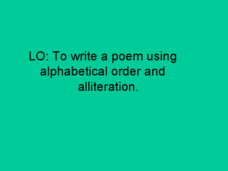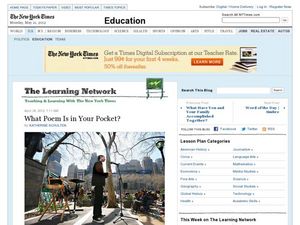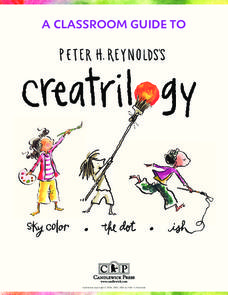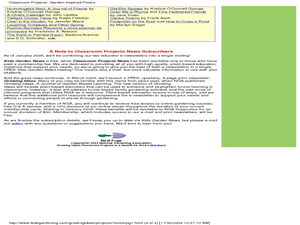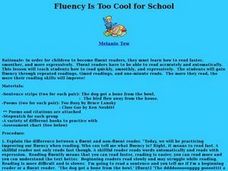Curated OER
Black History Lesson Plan: Gwendolyn Brooks
Learn more about the work of Gwendolyn Brooks with a language arts lesson. Young learners read an informational passage about the acclaimed poet before attempting a shape poem of their own.
Denver Art Museum
The Poetry in Non-Events
The photograph, Nellie and her Italian Soda is viewed and discussed by the class. They are instructed to use the photograph as inspiration to write a poem about non-events, or things that are beautiful in every day life. Pupils use a...
Curated OER
Poet Analysis: Ciaran Carson
Students analyze lyrics and narration by reading poetry. In this language arts lesson, students read and examine the poem Belfast Confetti. Students discuss the topics and questions asked by the author Ciaran Carson.
Curated OER
All Aboard!
Learners recognize and identify onomatopoeia. They will read the book All Aboard! A True Train Story, by Susan Kuklin. After reading the book, they list and illustrate examples of onomatopoeia. Then they write a poem or story using...
Curated OER
Personification
Young writers discover that personification is when a writer gives an object the qualities of a person. After practicing identifying personification in many of the slides, individuals compose their own poem that uses this technique. They...
Curated OER
Writing Review
This presentation provides a series of activities that can be used as morning warm ups throughout the week, or as a writing review. Learners put words in ABC order, learn about alliteration, correct punctuation in a series of sentences,...
Curated OER
Dance: Sharp and Smooth Energy Qualities
Students use different qualities of movement to express themselves. In this lesson on movement, students use different qualities of energy and then use their experience as an inspiration for writing poetry.
Curated OER
Poem in Your Pocket Day: Ideas for Celebrating
First instituted in New York City in 2002 and recognized nationwide in 2009, "Poem in Your Pocket Day" is part of National Poetry Month (April) and celebrates poetry in everyday life. A brief news story includes 9 ideas about how to...
Curated OER
Calligrams
Poetry can inspire learners to create beautiful works of art. In this presentation, they are shown how to design calligrams, a type of poetry that uses words as art. This is a creative way to motivate learners to explore poetry.
Curated OER
Guided Reading: Three Little Pigs (Plus Wolf: Javalinas)
Guide your class through reading various versions of The Three Little Pigs. Talk about the traditional story line and then discuss a different point of view: Maybe the wolf was just an innocent bystander! This lesson plan, which has...
Curated OER
What is a Haiku? How Do You Write a Haiku?
Haiku poetry is explored in this language arts lesson. Yong readers identify the characteristics of haiku and read several examples. Students make connections between their study of Japan and the poetic form of haiku, and they write...
Curated OER
Camels (Acrostic Poem)
In this writing and language arts worksheet, students use the letters in CAMELS to begin each line of an acrostic poem. Students may use a sentence, word or phrase for each line.
Curated OER
Observing Connections: Art, Poetry, and the Environment
Students write poems. In this language arts lesson, students view the works of Edward Hicks. Students write a poem and illustration based on the style of Edward Hicks.
EngageNY
Developing Reading Fluency: Selecting a Text and Practicing Reading Aloud
Young readers continue to strengthen their fluency skills with a text of their choosing. The teacher first engages the class with an audio recording or read-aloud of a short poem, modeling for children how to read fluently. Next it's...
EngageNY
Reading about Freaky Frogs: “The Water-Holding Frog"
Boost reading comprehension skills with a lesson all about freaky frogs. A poem hooks scholars and takes them into a reading of an informational text followed by peer discussions. A three-page worksheet focuses on text features and...
Candlewick Press
A Classroom Guide to Peter H. Reynolds's Creatrilogy
Help young readers find, identify, and use their voices with a set of empowering activities based on Peter H. Reynolds' trilogy of books. Sky Color, Ish, and The Dot focus on recognizing moods and treating each other kindly, and their...
Curated OER
Growing Poems
Students write garden inspired poetry. In this poetry lesson plan, students go out into the garden and write poems about how they feel, what they see, and what is going on in the garden.
Curated OER
"Leap, plashless": Emily Dickinson & Poetic Imagination
Students examine different poems from Emily Dickinson. They practice listening for meter in the poems and make connections between the texts. They also practice their own creative writing skills.
Curated OER
Creature Feature Poetry Keyword Search!
Young scholars examine the differences between fact and opinion, and brainstorm ideas for a keyword list by analyzing facts. They listen to poems, and create posters listing three keywords about each creature featured in the poetry.
Curated OER
Pirate Poems
Students increase their awareness of the fundamental of poetry. They write their own poetry on a familiar topic. Students create a paper-bag puppet on which to display their poem. They are told that poetry is a special way to tell a story.
Curated OER
Fluency Is Too Cool for School
What does a successful reader sound like? Help readers gain fluency and become successful readers through repeated readings of given poems. They use the cover-up method to help them decode new words and chart their progress as they...
Curated OER
Kennings: Poetry
Using a list of adjectives, learners answer a riddle. Through this creative presentation, your class can review the use of adjectives and descriptive language. They read a poem full of adjectives and guess which animal is being...
Curated OER
China Acrostic Poem
In this creating a poem worksheet, students use the letters in CHINA to write an acrostic poem. Students write 5 lines about the country China.
Curated OER
Language Arts: Awesome Authors Website
Students examine the writing techniques of professional authors and apply them to their own work. In pairs, they email authors to discover the tricks of the trade. Students create their own Website for their work.







